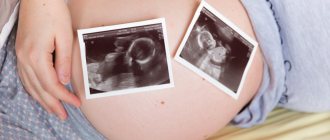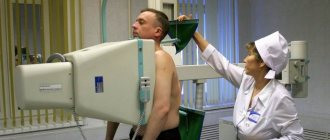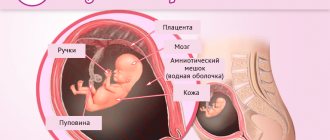Currently, multiple pregnancies are not as rare as they were several decades ago. The thing is that the use of assisted reproductive technologies increases the likelihood of bearing twins, or even triplets. If previously the probability of having fraternal twins was 1 in 80, now the frequency has increased. Identical multiple pregnancies occur in 4 cases out of 1000. You can determine how many fetuses the expectant mother is carrying using an ultrasound.
At what stage of pregnancy can a multiple pregnancy be determined?
There are two types of multiple pregnancies - identical and fraternal. Sometimes a woman produces two eggs in one cycle, and they are both fertilized by sperm. This is how dizygotic embryos are formed - twins. During IVF, 2-4 embryos are implanted into a woman at the same time to increase the likelihood that one of them will take root. However, often both embryos take root.
When can you see on an ultrasound how many fetuses the expectant mother is carrying? It is possible to examine fraternal twins using ultrasound as early as 5 weeks of pregnancy.
If the zygote formed as a result of the fusion of an egg and a sperm suddenly divides into two cells, identical twins are formed from it. If separation occurred in the first 3 days after conception, then each of them will have their own membrane and separate placenta. If separated before day 10, the embryos may share a placenta or amniotic sac. The separation, which occurred after the 13th day, results in the formation of conjoined twins.
Monozygotic multiple pregnancies become visible starting at 12 weeks of gestation or later. This is due to the location of the embryos, usually one of them is behind the other, or they are too close to each other.
You can suspect a multiple pregnancy even before an ultrasound scan. A woman has an increased level of hCG in her blood, its value increases in proportion to the number of embryos. As a rule, pregnant women experience more severe toxicosis; the belly begins to grow already at 3 months and has larger volumes than when carrying one child.
FAQ
When does it become known that there will be twins?
Sometimes in the sixth week of pregnancy, a transvaginal ultrasound can record a heartbeat (or even two!). However, it will be possible to speak with any accuracy about the presence of a second child only after an ultrasound scan at the 12th week.
What weight gain can be considered normal during twin pregnancy?
If your weight was normal before pregnancy, your total pregnancy gain should be between 16.5 and 24.5 kg. Your doctor will be able to give you individual recommendations, since weight gain and its rate depend on many factors.
Having twins can be difficult, but it's more than worth the joy. You could say it’s twice as much hassle, but also twice as much pleasure. Naturally, two newborns at home require a huge amount of time and effort, but the joy of communicating with the kids will outshine everything. You can do it!
Features of ultrasound during twin pregnancy
Multiple pregnancies often come with complications:
- severe toxicosis;
- increased risks of miscarriage or fetal death;
- placenta previa;
- placental abruption;
- incorrect position of the fetus;
- intrauterine growth retardation.
Twins are usually born prematurely. The average delivery time for twins is 37 weeks, triplets - 33 weeks, quadruplets - 28 weeks. There is also a risk of uneven blood flow to the fetuses and the sudden death of one of them, which leads to neurological disorders for the surviving infant.
That is why doctors pay special attention to the course of multiple gestations. If a woman pregnant with one child only needs to have an ultrasound scan once a trimester, then the expectant mother of two children will have to visit the ultrasound room every month.

Sometimes the doctor does not see multiple births in the image. This happens due to outdated equipment or inconvenient placement of twins. In monochorionic monoamniotic pregnancy, identical twins are not visible in the first months. If the results of the tests and ultrasound do not match, then the woman is prescribed a repeat examination after 2-3 weeks.
If twins are detected at 5 weeks, the doctor may not report this immediately, but wait until 10-12 weeks. Sometimes one of the embryos resolves and is absorbed by the placenta - this does not cause any harm to the second embryo, and the expectant mother may not know about it.
An ultrasound is performed through the abdominal wall. No special preparation is required for the procedure, but for a few days it is better to give up gas-forming foods - legumes, cabbage, apples. Transvaginal ultrasound is done only in special cases when it is necessary to identify fetal pathologies.
Development of twins by week: first trimester of pregnancy
It is generally accepted that a trimester is 13 weeks. What happens to babies in the womb at this stage?
A multiple pregnancy is a little different from a normal pregnancy. One of these differences is the somewhat accelerated development of fruits. I offer you an approximate description of what is happening to your body and to your babies:
- 4-7 weeks - fruit growth is 20-30mm, the development of the brain and internal organs begins. The expectant mother may feel the first signs of pregnancy: breasts swell, mild nausea appears
- 7th week - embryo growth is 8-10mm, the outlines of the head and limbs appear, eyes, mouth and ears appear on the head. There is a possibility of miscarriage, it is determined during examination
- 12th week - babies grow to 5-6cm, the risk of miscarriage decreases. You can already get to know them by undergoing an ultrasound. The fruits have the outlines of nails and teeth, their height can reach 15cm, and their weight can reach 1g. They can already respond to stimuli by clenching their fists and make their first attempts to swallow

What parameters are examined in the early stages, as can be seen in the ultrasound photo?
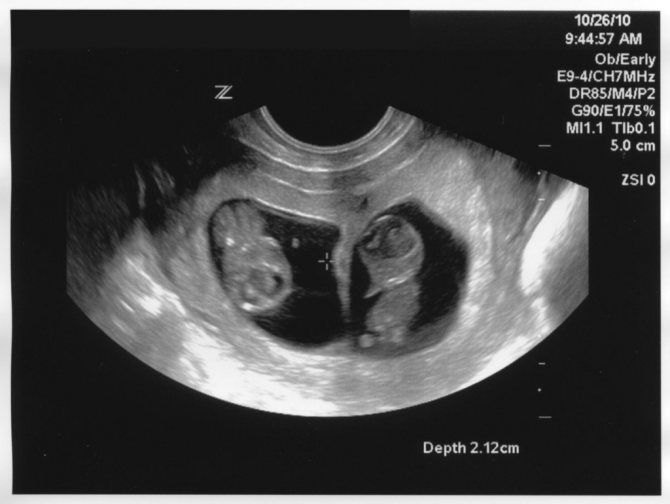
What does twins look like in the early stages? At first, the doctor sees only two dark spots. In addition, two heartbeats can be clearly heard, two placentas and two amniotic sacs are visible. In the photo you can see an ultrasound scan of the twins.
In the early stages, an ultrasound scan evaluates the following fetal parameters:
- coccygeal-parietal size - KTP, twins are usually smaller than single embryos, and by week 12 they reach a height of 6 cm and a body weight of 8 g;
- biparietal size - BDP, the distance between the temporal bones of the skull;
- heart rate - 110-150 beats/min;
- formation of the neural tube;
- presence of a nasal bone;
- the thickness of the collar space - its expansion along with a decrease in the nasal bone indicates Down syndrome;
- formation of internal organs.
It is often noticeable in an ultrasound image that one embryo is smaller than the other. If the discrepancy is small and only a few millimeters, then there is no need to worry, the sizes will even out either during pregnancy or after the birth of the babies.
Development of twins by week: second trimester of pregnancy
- 20th week - by this time the growth of the fruit reaches 25 cm, the weight is already 250-300 grams. Babies begin to respond to sounds, the urinary system and intestines of the fetus begin to work. The expectant mother already clearly feels movements and tremors
- 24th week - height about 30 cm, weight - 600g, hair appears on the body, the outlines of eyebrows and the first eyelashes are already noticeable on the face, noses are formed. The head is still disproportionately large
- 27th week - starting from this period, the fetuses are considered viable in case of premature birth. Vital processes in the lungs are formed, weight can reach 1 kg, height 35 cm. Since twins grow quickly, the pregnant woman feels discomfort due to a large belly and lower back pain. Due to the increased load on the legs, it becomes difficult to walk a lot
Possible deviations and ways to eliminate them
Multiple pregnancy is often accompanied by complications. In the early stages, there is a high probability of miscarriage. Most often, miscarriage occurs due to hormonal imbalance, unpreparedness of the genital organs to bear two embryos. If the expectant mother goes to the hospital on time, then doctors will be able to continue the pregnancy in a hospital setting. It happens that only one embryo dies in the womb, in which case an operation is performed to remove it.
A dangerous complication is feto-fetal transfusion syndrome, which occurs in 5-17% of cases of monochorionic pregnancy. In a single placenta, the blood flow of the embryos is connected, which is why blood from one embryo goes to the other. The “donor” develops tissue hypoxia, intrauterine growth retardation, and kidney pathologies, while the “recipient” develops heart and kidney failure.

If the syndrome occurs before the 26th week of gestation, the babies usually die or are born with severe disabilities. There are two ways to treat pathology:
- umbilical cord occlusion - surgically stopping the blood flow in one of the umbilical cords;
- laser coagulation - burning of anastomoses connecting the bloodstream of the fetus.
Operations are performed up to 25 weeks. The survival rate for one twin is about 85%. Doctors have to sacrifice one child to save the other, so that both twins do not die.
How does childbirth go?
Childbirth, like pregnancy with twins, is more difficult than for others, and there are a number of reasons for this.
- Firstly, the position of two or more fetuses is often unpredictable, so natural childbirth is not always successful, although such cases do occur. But even with the apparent absence of alarming facts during pregnancy, in the end you still have to do a cesarean section. However, today it is not so scary, and there is no need to be afraid of it.
- Possible complications during childbirth also include tangling of the umbilical cords, which often causes additional troubles for doctors. All this serves as a reason for mothers carrying twins to be hospitalized in advance, most often 3-4 weeks before delivery, in order to carefully study the mother’s body and prepare for all possible developments of the situation.
However, the overall positive impression of giving birth to twins cannot be overshadowed by any of the problems that young mothers have to go through. We have not yet examined in detail the general discomfort, fatigue, etc. from carrying several babies at once. But reviews about twin pregnancy are extremely positive.
Development of twins by week: third trimester of pregnancy
- 32nd week - the formation of the skeleton is completed. The twins weigh about 1.5 kg, height up to 40 cm. Each fetus has its own sleep cycle. The bodies begin to catch up with the head in proportions, the pancreas begins to work
- 34th week - the expectant mother feels pain in almost the entire body, fatigue appears. If one of the babies falls head down, there is a slight relief because the stomach drops and stops putting pressure on the diaphragm and internal organs
- 36th week - nails protrude beyond the edges of the fingers, the formation of fat under the skin ends. Weight 2-2.5 kg, height up to 45 cm. Twins are smaller in size than one baby at this stage, but often their lungs and other body systems are more developed
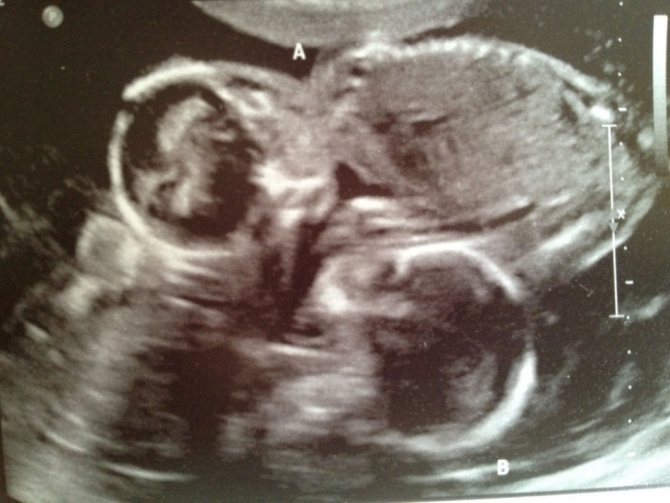
Twins, third trimester
